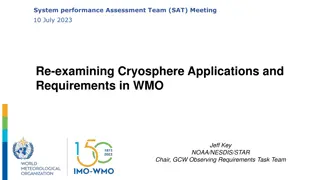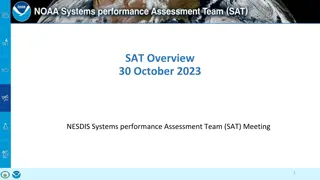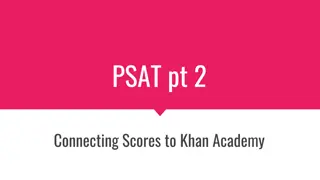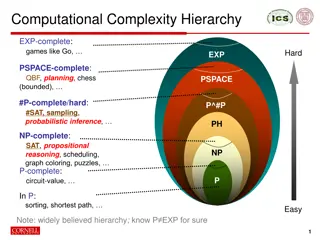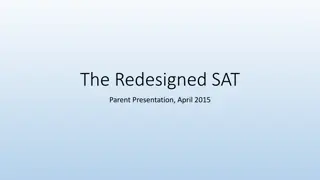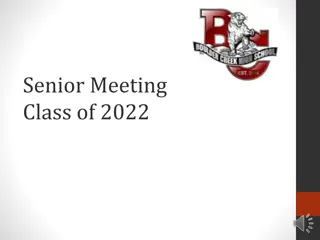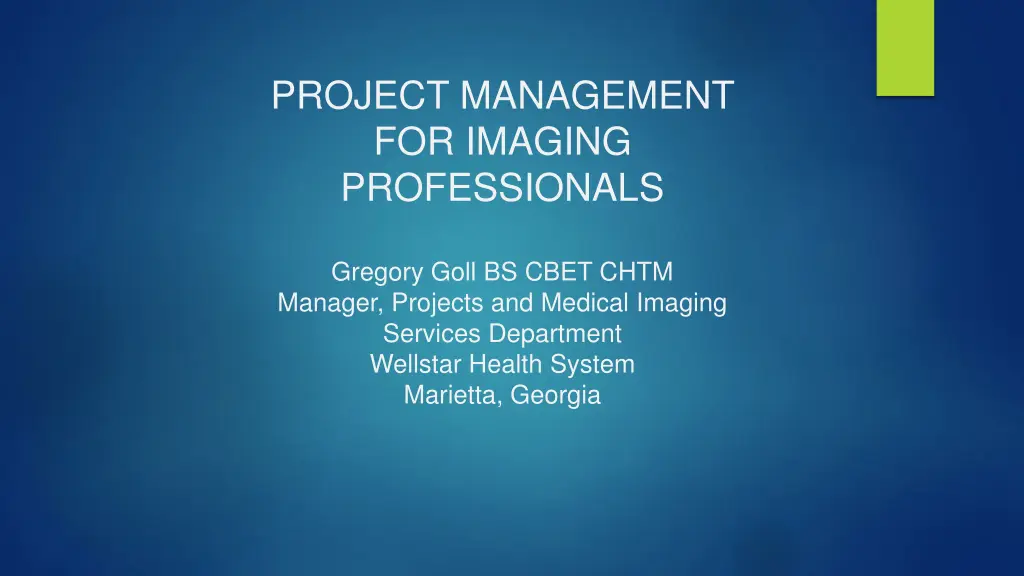
Effective Project Management Strategies for Imaging Professionals
Explore key insights into project management for imaging professionals, including project phases, stakeholder involvement, and the cost of project failure. Learn from Gregory Goll's extensive background in healthcare systems to enhance your project management skills. Clear communication and understanding project life cycles are vital components in successful project outcomes.
Download Presentation

Please find below an Image/Link to download the presentation.
The content on the website is provided AS IS for your information and personal use only. It may not be sold, licensed, or shared on other websites without obtaining consent from the author. If you encounter any issues during the download, it is possible that the publisher has removed the file from their server.
You are allowed to download the files provided on this website for personal or commercial use, subject to the condition that they are used lawfully. All files are the property of their respective owners.
The content on the website is provided AS IS for your information and personal use only. It may not be sold, licensed, or shared on other websites without obtaining consent from the author.
E N D
Presentation Transcript
PROJECT MANAGEMENT FOR IMAGING PROFESSIONALS Gregory Goll BS CBET CHTM Manager, Projects and Medical Imaging Services Department Wellstar Health System Marietta, Georgia
Wellstar Demographics 9 Hospitals 21 Imaging Centers 17th Busiest Emergency Room in country, 2nd Busiest Emergency Room in Georgia One of the largest healthcare providers in Georgia
Background 1985 Started University of Michigan Health System, Ann Arbor, Michigan 2001 Transition to Supervisor at Erlanger Health System, Chattanooga, Tennessee 2015 Transition to McLaren Health System, Mount Clemens, Michigan 2017 Currently with Wellstar Health System, Marietta, Georgia
Thought for the day If you can't explain it simply, you don't understand it well enough. Albert Einstein
THE COST OF PROJECT FAILURE Project Management statistics noted the following: Projects go over budget by 27% on average, and one in six projects has a cost overrun of 200% 17% of IT projects go so badly that they can threaten the very existence of the company 73% of respondents feel that their projects are either always or usually doomed right from the start IT failure rates are between 5-15% representing $50 Billion to $150 Billion in loss per year.
PHASES OF PROJECT MANAGEMENT Initiating Planning Executing Monitoring/Controlling Closing ** These are universal definitions**
PROJECT LIFE CYCLE Project Life Cycle The phases that a project passes through from initiation to the final closure. ** Every project that begins at some point has to end. ** Project Phases- These are the milestones/progress of a project.
STAKEHOLDERS Any person/group that may be affected by the outcome of project or a decision or activity that is the result of a project. There are many different definitions for stakeholders in a project. Importance they are the end users of the completed project.
SPONSOR A person or possibly a group that provides the resources and support for a project. Importance- They basically are the money controller, any budget changes directly affect them. In most cases they report to higher administration.
PROJECT MANAGER (PM)/ PROJECT TEAM The PM is a person designated by the organization to lead the team that is responsible for achieving the project objectives. The group of individuals that support the project manager. Importance- They are the leader over the project, they make assignments to other team members and track the overall progress of all aspects of the project.
PROJECT SCOPE The work done to deliver a product or service. Importance- This is the baseline of what is being asked to be completed. This should have define parameters to insure project is completed and meets desired objectives.
PROJECT SCOPE Money Tools People Materials Data Relationships
HUMAN RESOURCES Internal Staffing External Staffing Vendor Resources
RELATIONSHIPS In this case relationship is defined as a set of expectations. All vendor communications need to be consistent. Set a standard for all external interactions. A good example of this how incoming inspection and initial inventory process is handled.
PROJECT TIME LINES Timelines are used to set a base schedule for all team members to follow. Importance- If timelines are not tracked it is difficult to determine the status/completion of work.
PROJECT MANAGEMENT SOFTWARE Microsoft Project This has many tools for setting time lines, allocating of resources, and measuring project work. This is a nice way of linking several different paths of project work together. Also Microsoft Excel can be used as another option. ** Always make sure all team members have access to any program being used.
Team member tracking of projects Establish a process for all internal and external members to track project progress Microsoft Teams is an example of a universal software that allows establishment of a shared site for access and tracking of information and updates. Verify everyone is included on any important communications.
RISK ANALYSIS An event or condition that if it happens can have a positive or negative affect on one or more project objectives. Define risks associated with a project. (Breakdown Structure) How much risk can the sponsor take on. (Appetite) How much risk can the organization stand. All projects have some sort of risk.
IMPORTANCE OF MEETING NOTES / GENERAL DISCUSSIONS Documentation of progress. Documentation of assignments. Documentation of changes. Clarification of understanding. Defining aspects of a project.
CRITICAL PATH A sequence of activities that define the longest path through a project. Why it is important- Any process that interrupts the critical path will have a global impact on project time line and success.
SCOPE CREEP The uncontrolled expansion of a project. The main issue is as the project expands provisions were not made on how this change is to be funded. This will also tie up resources such as team members. This will effect final time lines in the majority of cases.
SCOPE CHANGE This happens when it is determined the path of a project must take a different direction than originally planned. This usually will require a change in project cost and any time lines. Between Scope Creep and Scope Change, change at least takes a direct. Scope Creep can potentially continue to grow in many directions.
COMPRESSION/PROJECT CRASHING/FAST TRACKING Compression Maintain all aspects of the project, only decreasing the overall time to complete. Project Crashing- A technique used to shorten the schedule duration for the least incremental cost by adding resources. Fast Tracking - the process of performing tasks in parallel so as to be able to finish the project sooner. Dysfunctional- A technique used to insure success is not an option.
ACCEPTANCE CRITERIA A set of conditions that must be met for before a deliverable can be signed off. Importance- This is the only way to be sure a goal has been met. A sign off must be from a person that has been designated to have the power to approve.
PLANNING FOR INSTALLATION Clear understanding of the project scope. Definition of time line. PM and Project team identified. Clearly define who does what in the process. Routine update times are scheduled.
WAYS TO BUILD A PROJECT BUDGET Long Term- when a start date is somewhere in the future, potentially years. Use list price and adjust for future increase. This will be revised. Short Term- Project has a defined start date and funds are available quickly. Use most accurate pricing available. Build it to fit- The can be the hardest. You have a set amount of money that can not be increased.
BUDGET DEFINING FACTORS Is there a predefined budget? Has the scope been determined? Did you add everything you need to the budget? Is there selected vendors or a bid process? Is the installation in a new area or an existing area? Are you attempting to reuse anything without checking?
PAYMENT TERMS / ISSUES Are the funds available? How much money is committed upon arrival? How much money is due on final approval? If possible know how long it takes for your employer to pay an invoice.
ORGANIZATION OF THE PROJECT Blue print control. Estimate/ revision control. Project Notebook, file, or online tracking. Create a shared access for all team members to communicate important items like budget planning.
BEFORE YOU VOLUNTEER TO TAKE ON A LEADERSHIP ROLE, SOMETHING TO THINK ABOUT Bandwidth in life, sometimes leading a project requires altering work hours or overtime Communication ability, it s not only what you say. It s how you say it that matters. Patience is extremely important
INTERNAL DEPARTMENT BUDGETING Accurately project how much time a project will take from start to finish. Make sure of who internally you want involved. Who will pay the labor for involvement in a project? How soon can back billing begin?
HAVE A PLAN/ BE CAREFUL Before any work begins have a plan on exactly what is being done. Know your expected role. Know boundaries of your role. Do not take on tasks you are not able to control. Do not make time promises you can not keep. Make a contingency plan.
COMMON PITFALLS Purchasing equipment with user input. Joining late in a project and approaching involvement as a reactive verses proactive. Not taking the time to properly verify information, details and contacts. Not taking time for measurement verification. Lack of engagement with clinical staff. Making changes without proper approvals.
COMMON PITFALLS CONTINUED Deliberately working outside of area of responsibility. Unfunded equipment replacements (consignment) Quick purchases, only device not all pieces Interfacing to non-compatible equipment
Imaging Complications Did the site ever have Imaging equipment? Who has access to any shielding designs? Was consideration made for the weight of the equipment? How do you get the equipment in the building? How do you get it back out? Nothing lasts forever.
FIVE WAYS TO GET IT DONE WRONG, OR NOT AT ALL! Scope-less is hopeless. Don t decide what you are doing just throw money at a problem. Focus on time and cost, not quality. Get it done yesterday. Never let anyone spend money. Don t waste time checking anything just get it done. Know the right thing to do. Don t analyze problems. Don t listen to experts. And absolutely, above all, whatever you do be sure to ignore the customer. You wouldn t launch a project if you didn t know everything, and what does anyone else know? Don t thank the team, push them harder. Don t waste time with planning, People ought to know what to do. Just tell the team to get it done now or else. Avoid big problems. All of our projects fail. And we ve got no time for them, either we re too busy putting out fires.
Thanks for attending Any Questions?

